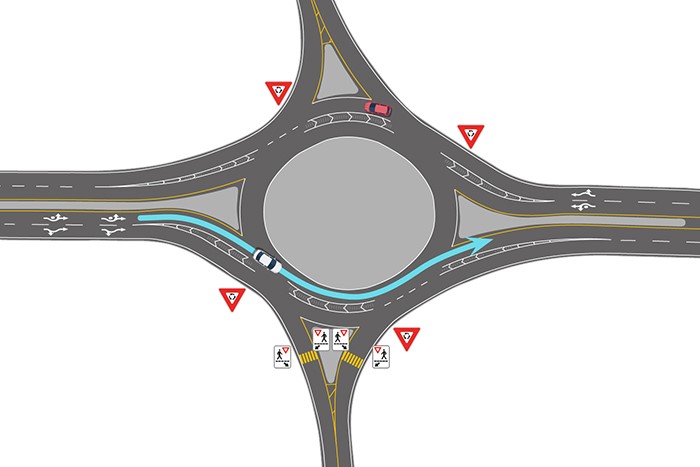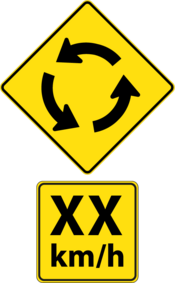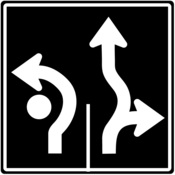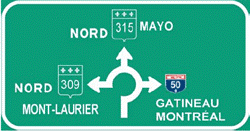Intersections
Rules and Good Practices for Driving in a Traffic Circle
A traffic circle is a type of circular intersection where one, two or three traffic lanes surround a central island. It allows you to cross an intersection by giving way to users that are already engaged in the circle.
Rules and Good Practices for All Road Users
Whether you are driving or riding a bike, you must drive counter-clockwise, i.e., from the right to the left.
When you are approaching a traffic circle:
slow down;
choose the lane that will lead to your destination;
give way to the users already in the circle; and
if there is a lot of traffic, come to a complete stop before entering the circle.
Once you are in the traffic circle:
drive counter-clockwise;
use your blinkers to signal your exit; and
take your desired exit.
The image below illustrates in which way to drive when engaging in a one-lane traffic circle.

This image shows a two-lane traffic circle. In this example, the driver has chosen to continue straight ahead.

Never stop your vehicle while driving in the traffic circle. If you miss your exit and the intersection’s design allows it, make a second turn around the circle.
Sometimes, there are crosswalks in the traffic circle branches. In this case, both road vehicle drivers and cyclists must give way to pedestrians engaged in crossing or clearly indicating their intention to cross the road.
To learn more about how to drive through a traffic circle, watch the video Ralentissez, on tourne! (Slow down, we’re are going around!).
Rules for Cyclists
Bicycles should be ridden in a single file and as close to the curb or right side of the road as possible. Drivers must yield to users already engaged in the intersection, including pedestrians.
Rules for Pedestrians
Pedestrians cannot cross the roadway or walk in the centre island of a traffic circle. Instead, you should walk around the intersection using crosswalks and sidewalks where appropriate.
Traffic Signs
The following signs provide information on what to do when approaching a traffic circle.
Recommended speed
When the speed limit at the approach of a traffic circle is greater than 50 km/h, road signs will indicate the upcoming intersection and the recommended speed.

Traffic lanes
The signs below are placed before entering a multi-lane intersection to help you choose the lane leading to your destination.

A sign, such as the one below, can also be placed before entering a traffic circle to help you choose the lane to take, if applicable, and the correct exit once you are in the traffic circle. It shows the location of each branch of the intersection and the destinations that can be reached by each branch.

Traffic Circle Advantages
Traffic circles offer several advantages in terms of road safety, traffic flow and the environment.
Road safety
Since traffic circles reduce speed and conflict points compared to intersections, they help:
reduce the number of accidents with injuries;
eliminate high-speed right-angle collisions; and
reduce the severity of accidents.
Traffic
Traffic flow is improved because vehicles rarely have to come to a complete stop before entering a traffic circle.
Environment
Traffic circles help protect the environment by reducing noise because heavy vehicles do not have to come to a complete stop or use their engine brakes as often. They also reduce gasoline consumption and, as a result, air pollution. Appearance is also improved by planting vegetation in the central island.
Last update: November 1, 2023



